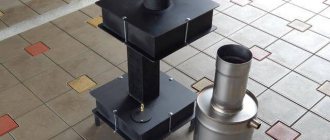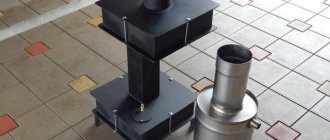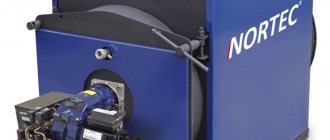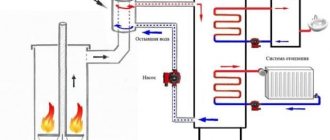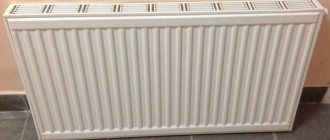One of the cheapest types of fuel used to operate heating boilers is waste oil. It can be anything: synthetic or natural. Oil drained from cooking units, cars or diesel locomotives is suitable.
In any case, when burned, it will produce a large amount of heat. Therefore, assembling a waste oil boiler with your own hands is very profitable. Especially if you need to heat a utility room or garage.
We will tell you how the heating device is designed and works, what are the design nuances of a home-made unit, and also describe the step-by-step process of assembling the boiler and the features of its operation.
What is used oil?
Refining is an oil-based product that is obtained during long-term operation of a car engine. Under the influence of external factors, the oil loses its normal characteristics and becomes unsuitable for further use. The mass of the product contains a whole complex of various particles formed during the operation of metal parts of mechanisms.
The used oil must be drained and replaced with new oil. When replacing, it is recommended to dispose of the waste at special collection points, where it finds its useful use in the form of fuel for heating the room.
Production of a boiler for development
Almost anyone can make a working boiler. There are many designs and methods, all of them have been tested in practice and are widely used. There are two main designs, let's look at them.

Drawings of heating units
In the first case, the boiler consists of two chambers connected to each other by a pipe with holes. The evaporation compartment is located in the lower chamber, where open combustion of the waste occurs. Afterburning occurs in a pipe with holes into which air is supplied naturally. After the pipe there is a second chamber, in which the speed of movement of fuel vapors decreases.
The partition in the upper compartment also serves for complete oxidation and connection with nitrogen. A chimney is installed higher, it serves to remove combustion products and additional draft. Light the boiler using a rag soaked in gasoline or kerosene. In the lower compartment there is a special damper that regulates the air supply to the first combustion chamber. For hot water supply and heating systems, a water jacket is installed in the second compartment. It is important to leave a gap between the pipe and the tank of at least 70 mm.
The second manufacturing method involves more economical use of fuel.
The power of the device can reach 15 kW.
The design contains a turbine for forced air supply. Increased boost burns the fuel mixture more efficiently. The waste tank is taken out separately and a valve is installed on it to regulate the oil supply to the boiler or stop it completely. As in the first case, the central pipe is equipped with slots or holes for efficient combustion of fuel vapors. The waste combustion products are also removed through the chimney; when installing it, sharp corners and sharp turns should not be allowed. Recommended length is at least 4 m.
This design allows you to comply with all safety requirements, and also makes it possible to easily install water elements of the heating system. The most economical.

Necessary materials
When making a waste oil boiler, the following materials may be needed:
- Gas cylinder with a volume of at least 50 l
- Metal pipes with diameters of 100 mm, thickness of 3 mm and 6 mm
- Metal sheets from 3 mm to 5 mm thick
- Car brake disc
- Steel pipe with a diameter of 15 mm
- Fireproof Fuel Supply Hose
- Ball valve
- Oil tank
- Steel cover, at least 5 mm thick
- Steel sheet no thinner than 3 mm, for water jacket
- Set of pipes for connections
It is recommended to use special products to protect against rust; this will extend the life of the boiler. In places where pipes are connected, paste and tow are used to increase sealing.
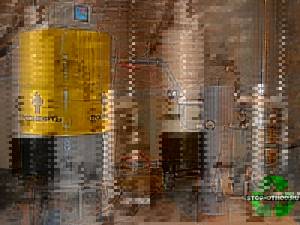
Tools used for manufacturing
During work you may need a variety of tools:
- For welding connections, transformer machines or inverters are used, since such connections are subject to increased requirements.
- Drill kit and hand electric drill to make holes for mounting and torch.
- Set of pipe thread dies.
- Grinding machine, two wheels for it: cutting and cleaning.
- Tape measure, metal ruler, gas wrench and device for marking on metal.
Before starting work, it is recommended to secure the welding site, and also use coolant when drilling.

Instructions for making a boiler for testing yourself
In order to make a waste oil boiler with your own hands, you must follow the following instructions:
- The gas cylinder must first be emptied. The valve is turned off from above, the container is turned over and all the contents are drained. The cylinder is washed with water, only then can welding and cutting work be carried out.
- Two openings are cut out in the container, leaving a strip of at least 50 mm between them. The upper compartment is made larger so that firewood can be loaded into it. The cut parts are not thrown away; these will be hatches for loading fuel.
- Hinges are welded to openings and hatches.
- A ring equal to the inner diameter of the cylinder is cut out of a sheet of steel 4 mm thick, and a hole is made in it slightly larger than the diameter of the burner (100 mm). Serves as a partition between the combustion compartment and the heat exchanger.
- Cut a piece 200 mm long from the steel pipe, make holes on the entire surface for a length of 95 mm.
- The burner blank is inserted into the previously made ring up to the holes and welded.
- The partition is installed at the level of the upper combustion compartment.
- A brake disc from a passenger car can serve as a blank for the evaporator. It is first necessary to close all the technological holes from the bottom and top; for this, two rings are cut out of a sheet of steel, one will be the bottom, and the other will be the lid. Then they are welded, a hole is made in the cover for subsequent installation of the coupling.
- A 150 mm long section is cut from the pipe, then you need to cut it lengthwise and slightly move the walls apart to 3-4 mm. Afterwards, the workpiece is welded to the combustion bowl and attached to the burner.
- A water jacket is formed from a steel sheet around the boiler, and everything should be scalded with a continuous seam.
- Pipes for draining and supplying water are installed at the bottom and top.
- Mount the chimney in the lid and install it on the boiler.
- A hole is made in the wall of the gas cylinder, a tube is inserted into it at an angle, its end is placed above the fuel supply window. After adjusting the extension length, the tube is scalded.
- A thread is cut on the mining supply pipe and a tap connected to the barrel is installed.
Homemade designs
Self-made boilers for mining with a water circuit have a similar principle of operation, but they function somewhat differently. They do not have a burner as such. Its role is played by a container heated to high temperatures. Drops of oil falling on it instantly evaporate and the vapors ignite. This is not pure pyrolysis, since during microexplosions when fuel collides with a hot surface, additional energy is released from the disintegration of molecules.
The simplest exhaust furnace works as follows:
- The lower container is in the form of a bowl.
- Upper afterburning chamber of the enriched mixture.
- Perforated metal pipe with perforations for enriching vapors with oxygen.
Gasoline is used to ignite the fuel in the lower chamber. After combustion begins, the oil evaporates rapidly. The vapors rise up the pipe, become enriched and burn in the upper chamber. In this case, the temperature at the bottom rarely exceeds 350° C, and at the top 900° C. If oil is added to the lower bowl manually, a hole is made in its lid to allow fuel to be poured. For automatic supply, connect the pipe leading to the fuel tank.
The exhaust furnace has the following advantages:
- Versatility. It can be used in any enclosed space.
- Possibility to make it yourself.
- Inexpensive fuel.
- High heating speed.
- Compact sizes.
This system has only 2 drawbacks.
The first is the rapid contamination of the chimney.
It will have to be cleaned regularly. The second drawback is noise. When the air-oil mixture burns, a hum is heard. This is interesting: cleaning the chimneys of stoves and fireplaces from soot.
Advantages of heating boilers during testing
Heating boilers using waste oil have many advantages.
Economical

The boiler operates on primary waste oil. A properly configured device burns it completely .
More often, such devices are purchased by people who have access to fuel in unlimited quantities.
For example, workers at depots or engineering plants. But even if you have to buy used liquid, you will still be in the black.
The cost of oil is minimal, and it is consumed economically. The oil burns out completely, which means every penny spent on it will be spent.
Autonomy
Such a boiler operates autonomously, without connection to a stationary heating system . The buyer independently, regardless of the centralized supply of heat, decides where the device will be installed. This is relevant in private homes, where autonomous heating is extremely necessary in the cold season.
Simplicity of the device
The device is so easy to assemble and operate that some craftsmen are attempting to assemble it themselves. The operating principle of a homemade and purchased unit is similar, and the resources spent on manufacturing or purchasing are almost the same.
Affordability
It is no coincidence that such heating devices are extremely popular. Despite the fact that there are few manufacturers of such devices on the market, they do not inflate the cost, since they understand perfectly well that such a device can be assembled at home. Combined with the low price of fuel, the consumer can recoup their purchase within the first heating season.

Photo 1. Two boilers (yellow and red) running on waste oil. Manufacturer: Thermobile.
Wide range of applications
Waste oil boilers are used not only for heating residential premises. They can often be found in offices, institutions, and even industrial and warehouse areas. It is these factors that have influenced the fact that such devices have received a wide range of applications.
Environmental friendliness
The fuel burns completely. At the same time, no toxic waste or harmful substances are released into the surrounding atmosphere. The operation of the device is absolutely harmless to people and the environment. Many manufacturers' models are marked with environmental safety marks from various environmental organizations.
Efficiency of use
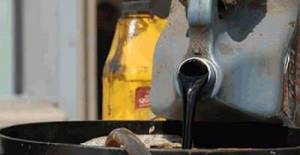
The device quickly heats the air and the room around it and maintains the set temperature. Warmth is felt almost immediately after turning on the device.
It not only remains in the room and does not disappear over time, but also spreads to other rooms.
Features of choosing a finished heating device
When choosing a finished heating boiler, you need to pay attention to what type of room it will be installed in, on what area, what type of oil is used, and also pay attention to the efficiency factor.
Modern technologies make it possible to produce double-turn units, both manual and fully automated. Some run on certain fuels, while others run on any fuel.
The boilers themselves are generally not recommended for residential premises, as they require special operating conditions. They are often installed in small industrial spaces.
Heater design and drawings
Craftsmen engaged in the manufacture of waste oil boilers use in practice 3 methods of burning waste:
- surface combustion with pyrolysis afterburning in a perforated pipe and secondary chamber;
- the use of Babington burners and other homemade structures;
- combustion in a flame bowl, fuel supply is organized by the drip method, air is forced.

The first option is implemented in the famous garage stove, consisting of 2 chambers connected by a vertical perforated pipe. We described the second method in detail in the corresponding publication - a Babington burner is made and built inside the body of a steel boiler that previously operated on wood.
We propose to focus on the third option - a dropper stove, converting it into a double-turn (the correct name is two-pass) water boiler. The drawing below shows the basic version of this stove, made from a Ø219 mm pipe. Why it is recommended for beginners to take the drip principle of operation of the heating unit as a basis:
- The design of oil burners is quite complex. Assembly requires some experience and financial investment (for example, for Babington you will have to buy a compressor).
- Surface combustion heaters are fire hazardous (they shoot out flames when water gets into the fuel). Equipping a miracle stove with a water jacket is not an easy task.
- Fuel consumption during surface combustion is prohibitively high - up to 2 liters of waste per hour.
- According to reviews on the forums, the drippers are reliable and can work without automation (however, the owner will have to devote some time to the boiler to get used to manual control). The unit is relatively simple to manufacture.
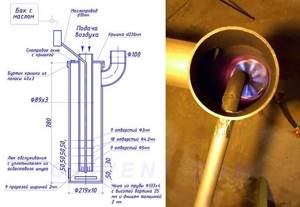
Dripper stove - a prototype of a two-pass hot water boiler for burning liquid fuels
Note. We discussed in detail how to make a drip stove using waste oil yourself in a separate step-by-step instruction. If you are interested in other types of homemade liquid fuel heaters, go to the authoritative thematic forum termoportal.ru.
Liquid fuel boiler diagram
The dropper diagram shown in the drawing needs to be redone, since together with the fire tube heat exchanger the structure will not fit inside the gas cylinder - you will have to look for a large pipe with a diameter of 400 mm. The dimensions of the heat generator can be reduced without loss of power (15-20 kW) as follows:
- make an afterburner from a DN40 pipe, changing the number and diameter of the holes (more precisely indicated in the drawing);
- for the combustion chamber, take a DN150 pipe;
- weld a water jacket from two propane gas cylinders;
- heat exchanger – at least 8 flame tubes Ø32 mm;
- bowl size - according to the combustion chamber (DN150);
- height from the edge of the afterburner to the bottom of the bowl is 6.5-7 cm.
Rating of the best models
When traditional heaters are not available, waste boilers become the most profitable and simple way out of a difficult situation. Considering that the equipment can operate on all types of liquid flammable materials, including animal fat and diesel fuel, it can be called ideal for emergency situations. By the way, to switch from one type of fuel to another, you just need to adjust the speed and volume of air required for combustion, which takes about 5 seconds.
| Category | Name | price, rub. |
| The best waste oil boilers made in Russia | GeKKON 50 | 108000 |
| Teplamos NT-100 | 268000 | |
| EcoBoil-30/36 | 460000 | |
| The best waste oil boilers made in Europe | Ecoheat 60 S | 280000 |
| Danvex B-60 | 290000 |
Other oil boiler manufacturers
Energylogic double-circuit liquid fuel boilers from the American manufacturer are distinguished by high quality workmanship, reliability and durability. Models have a power of 41-218 kW. The heat exchanger operates on a wet effect, cooling the water. This eliminates the formation of burnout points and helps slow down metal wear.
The fan burner has a special head that forms and holds the flame, normalizing the combustion process of the fuel. The devices have the ability to heat the fuel before it enters the injector. The boilers are equipped with a reversible two-pass firebox.

The Energylogic boiler heat exchanger operates on the wet effect, cooling the water.
Chinese Norteс waste oil boiler plants have a capacity of 15-7000 kW. Thanks to the presence of a mesh filter, the fuel enters the nozzle in its pure form. The devices are equipped with a fuel overflow sensor and a reliable sliding secondary air control flap.
Another Chinese manufacturer, Smart Burner, produces boilers with a capacity of 24-595 kW. The devices have a smooth ignition system and the option of adjusting the fuel supply, which contributes to greater efficiency.
Korean-made two-pass boilers operate on the basis of single-stage OLB burners. They have a power of 15-1600 kW. The devices are equipped with a pressure regulator, with which the fuel flow to the injector is adjusted, which is determined by the viscosity of the fuel. They have a system protection function in the event of a malfunction of one of the boiler elements.
Korean Kiturami boilers operate on different types of fuel. They are equipped with a self-diagnostic device, thanks to which the operating mode is adjusted. In the secondary combustion zone, the boilers have a burner with cyclone flow aerodynamics technology.
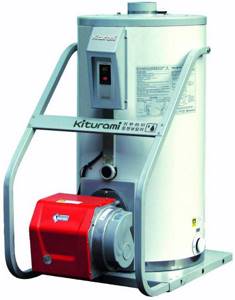
Kiturami boilers are equipped with a self-diagnostic device, thanks to which the operating mode is adjusted.
Currently, waste oil heating is very popular. This is primarily due to the economic feasibility of this option. Exhaust boilers are characterized by a number of distinctive advantages, but factory-made devices are quite expensive. To save money, you can make the device yourself, having studied all the intricacies of the process.
The best waste oil boilers made in Russia
Russian waste oil boilers are produced mainly in Voronezh. Today there are 10 more small enterprises engaged in the development and production of equipment according to their own engineering designs. However, not everyone has a state certificate for the production of heating equipment. When purchasing, it is imperative to read the documents, which guarantees safe operation.
GeKKON 50
A domestically produced pyrolysis boiler that can operate on crude oil, all grades of fuel oil, oils, fats, diesel fuel, kerosene, etc.
GeKKON 50
Specifications:
- Operating voltage – 220 V.
- Maximum temperature in the boiler – 95°C
- Dimensions – 460x660x950 mm
- Weight – 160 kg
- Fuel consumption - 2-5 l/hour
- Power consumption – 100 W.
The main advantage of this model is that almost all types of liquid hydrocarbons can be used as fuel. In addition, the unit is not critical to the viscosity and quality of the fuel; it does not require pre-filtration and heating.
In addition, there are several more advantages of the model - high efficiency, small dimensions, ease of maintenance and repair, reliability of all components and assemblies.
The average cost of the unit is 108,000 rubles.
Teplamos NT-100
A domestically produced boiler, which is designed for heating various industrial premises. The model is fully equipped and ready for launch. Double-circuit - used not only for heating, but also to provide hot water supply in the house.
Teplamos NT-100
Specifications:
- Dimensions – 1140x750x1180 mm
- Weight – 257 kg
- Maximum heating temperature of the coolant – 95°C
- Maximum thermal power - 99 kW
- Fuel consumption – 6 liters per hour
- Compressed air pressure – 0.8 – 1.0 bar
- Chimney diameter – 200 mm
The presence of a control panel allows you to control the equipment automatically. It includes a switch, thermostat, thermohydrometer, emergency thermostat.
A big plus of this model is the excellent thermal insulation of the boiler body made of high-density glass wool. All external elements of the case are powder coated to protect against corrosion.
The boiler has a door for maintenance of the combustion chamber, without the need to dismantle the burner.
The average cost of the device is 268,000 rubles.
Operating instructions Teplamos NT-100
EcoBoil-30/36
Single-circuit boiler designed to heat a room up to 300 square meters. meters for any purpose - residential buildings, industrial facilities.

EcoBoil-30/36
Specifications:
- Dimensions – 580x600x1100 mm
- Chimney diameter – 108 mm
- Water circuit volume – 38 l
- Boiler power – 28 kW
- Fuel consumption - 0.9-1.6 l/hour
The boiler can operate on waste oil, various vegetable oils, kerosene and automatic transmission oils.
The average price for this unit is 460,000 rubles.
Operating instructions "EcoBoil-30/36"
The best waste oil boilers made in Europe
Waste oil boilers are produced both in Russia and abroad. Oddly enough, the most popular are domestically produced boilers and those from Finland. Domestic boilers are the most reliable, and those from Finland are the most economical
Ecoheat 60 S
This boiler model, operating on waste oil, can be used to heat various premises - warehouses, hangars, car service centers and other production areas.
Ecoheat 60 S
The unit is equipped with a burner, delivered fully assembled, ready for use. It can be connected to a separate boiler to obtain water.
Specifications:
- Dimensions – 1020x670x790 mm
- Weight – 243 kg
- Tank volume – 100 l
- Fuel consumption – 5.4 l. at one o'clock
- Thermal power – 60 kW
- Availability of fuel tank
- Compressed air pressure – 0.5-1.5 bar
Installation of boiler and chimney
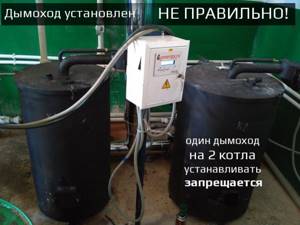
The oil heating boiler is placed in a pre-selected location at a certain distance from flammable elements. If desired, you can arrange a concrete platform with a protective edge, which will ensure safety during fuel overflow. It is advisable to mount the automation unit on the wall. Equipment must be easily accessible.
Wires and oil hoses are insulated so that there is no direct contact with the hot boiler. Thermal sensors are mounted on the side of the tube, and the waste container is placed within 1.5 meters from the heated surface of the structure.
When installing a chimney, the following rules are observed:
- the diameter corresponds to the pipe outlet;
- metal pipe thickness not less than 0.5 mm;
- no more than three turns;
- height not less than 5 meters.
The chimney should rise above the roof.
Organization of drip oil supply
To do this, perform the following actions:
- Cut a piece 30-40 cm long from a pipe with a diameter of 8 cm.
- Make two holes in the pipe: one 2 cm from the bottom, the other 4 cm from the top. The diameter of the holes is 1 cm .
- Fittings are welded to the holes.
- A circle with a hole in the center is welded to the lower end of the pipe. Hole diameter - 1 cm.
- A fitting is welded to this hole.
- Similar actions are done at the other end. However, the hole should have a diameter of 3-4 cm and instead of a fitting, a nut with the appropriate dimensions is welded. You need to screw a long bolt into this nut, which will serve as an adjustment rod. You need to make several small holes in the plug for air movement .
- Flexible hoses are attached to the fittings. Two side flexible tubes are lowered into a container with oil. Before this, a pump is placed at the end of the hose attached to the lower side fitting, and another piece of tube with an oil filter is attached at the end.
- A drip clamp or some equivalent is placed on a short hose connected to the fitting at the lower end of the pipe . This element will allow you to control the supply of used oil.
- The structure with hoses is suspended in a vertical position.
- A funnel is placed under the end of the hose with a clamp, from which a flexible tube extends. It is connected to a pipe that is located inside the air duct.
After this, the homemade boiler for heating the house is ready. It is worth saying that its use is not easy, because after each oil change you need to adjust the fuel supply, or rather the drop frequency.
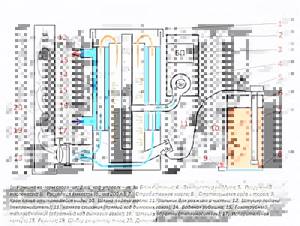
If the water jacket does not have time to absorb all the heat, then you can build a special chimney shown in various videos with an additional heat exchanger.
How exactly does oil evaporate?
There are 2 main ways to burn fuel and evaporate oil:
- Igniting a liquid substance. This releases steam. A special chamber is used to burn it out.
- Pouring a hot surface. A white-hot metal bowl is used. The waste drips onto its surface. When fuel comes into contact with hot metal, it evaporates. The “cooperation” of air and steam is called “diffusion.” When air enters the tank, the steam ignites and ignites. The result of this is the generation of heat.
Fuel consumption is quite economical. From ½ to 1 liter is used per hour.
European boilers, despite their excellent efficiency, do not make this operating principle possible. This is only relevant in the case of boilers from a domestic manufacturer.
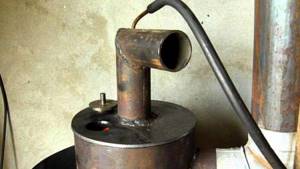
Warming up the boiler
The easiest way is to soak a wick in gasoline, light it and throw it into the tank. When the bowl is warmed up well, you can start adding oil.
It is important that the oil is supplied evenly. It is recommended to use the drip approach
To ensure the required level of waste filtration, you should use a car filter. It is put on a tube, one of the ends of which must be lowered into a container with waste.
The filter should be replaced at least once/30 days. If the fuel cannot be called clean, then it is recommended to do this once/15 days.
The amount of oil dripping onto the bowl should be optimal. The most important thing is to ensure that it burns evenly. It shouldn't smoke.
If the boiler owner has decided to replace the fuel, the drop frequency must be adjusted each time.
The installation should also be provided with maximum protection. Do not allow the oil to boil - this can lead to unpredictable consequences. The same applies to fuel overflow.
If the fuel level in the tank is higher than in the stove itself, a fire may occur. It can only be dealt with using a fire extinguisher.
Do not pour oil into the boiler while the unit is running - this can be very dangerous. It is best to install additional capacity. It will be possible to place the main supply of fuel in it.
Installation Tips
Installing a boiler that uses waste oil is practically no different from installing other types of heaters. There is one advantage: thanks to the presence of turbocharging and smokeless combustion of liquid fuel, the chimney does not have to be raised by 6-7 meters. It is enough to remove the chimney head from the wind pressure zone and raise it to a height of 4 m.
Regarding proper installation, we will give the following recommendations:
- The boiler and steel chimneys not protected by insulation are located at a distance of 0.5 m from combustible walls and other elements of a wooden house. The minimum distance from fireproof structures is 100 mm.
- Pass through the outer wall and the entire outer section of the flue with an insulated pipe - a sandwich, otherwise there will be a lot of condensation and soot. The chimney installation technology is described in detail in a separate material.
- Be sure to install a safety group on the heating supply line.
- Organize a good exhaust hood in the furnace to remove odors. Combustion air intake can be provided from the street.
- Equip the supercharger with a speed regulator and the oil line with a valve. This will allow you to control the power of the heat generator manually. Do not confuse the control valve with a regular tap; shut-off valves are installed on pipelines in any case.
- Make a primitive automatic emergency stop - install a thermostat on the supply, turn off the fan and the oil pump in case of overheating of the coolant.
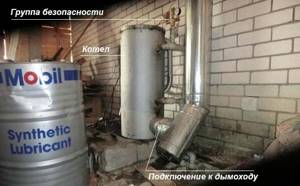
If the waste is fed by gravity, then for safety reasons it is advisable to install an electric shut-off valve on the fuel line. One subtlety: after an emergency shutdown, the boiler will not start on its own; you will have to light the oil manually or set up automatic ignition.
It is very advisable to insure the operation of the boiler in case of a power outage. A car fan, designed for a voltage of 12 volts, can be powered from a conventional battery, the rest of the equipment - pumps, thermostats - through an uninterruptible power supply unit.
The easiest way to supply used oil to the combustion chamber of the boiler is by gravity - from a container suspended from the wall. But such a system must be constantly monitored, plus as it is emptied, the interval between drops increases and the combustion intensity decreases.
Hence the recommendation: after the initial test of a double-turn boiler during testing, purchase a pump from a Ural motorcycle (or similar) and install it in a barrel of fuel. How to do this, see the latest video.
Operating principle
Used motor oils are called waste oils. They are a source of environmental pollution and do not burn well. This is explained by the inability of oxygen to oxidize the entire set of chemical elements included in the composition. But if it is possible to split the waste into simple components, then it turns into energy-efficient fuel.
The method of separating waste oil has been used in science for a long time - this is pyrolysis . Using this process, flammable substances can be separated from any type of fuel: wood, coal and oil. This process is simple and does not require additional financial costs.
The main advantage of pyrolysis is that when fuel burns, it maintains itself and even regulates itself . A person does not even need to interfere in this process.

